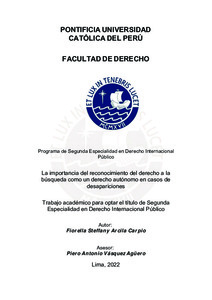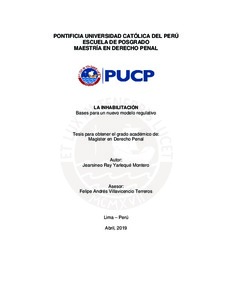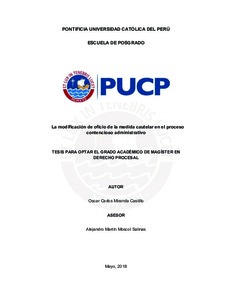| dc.contributor.advisor | Vásquez Agüero, Piero Antonio | |
| dc.contributor.author | Arcila Carpio, Fiorella Steffany | |
| dc.date.accessioned | 2023-10-26T21:04:53Z | |
| dc.date.available | 2023-10-26T21:04:53Z | |
| dc.date.created | 2022 | |
| dc.date.issued | 2023-10-26 | |
| dc.identifier.uri | http://hdl.handle.net/20.500.12404/26244 | |
| dc.description.abstract | Las desapariciones forzadas de personas trascienden desde hace décadas
atrás, pasando por diversos cambios a nivel histórico y con ello, también
normativo y jurisprudencial, tanto a nivel del Sistema Universal de Derechos
Humanos como a nivel del Sistema Interamericano de Derechos Humanos. Así,
se han ido incorporando e identificando nuevos elementos, siendo uno de estos
el derecho a la búsqueda de las personas desaparecidas.
Gracias a un desarrollo evolutivo en materia jurisprudencial, el derecho a la
búsqueda de las personas ha sido incorporado como parte de los elementos
intrínsecos del fenómeno de desaparición forzada. No obstante, dada su
reciente incorporación, este no ha sido desarrollado a nivel internacional como
un derecho autónomo.
En efecto, recién con la sentencia de la Corte Interamericana de Derechos
Humanos sobre el caso de la familia Julien Grisonas vs. Argentina, se
reconoció en setiembre de 2021 al derecho a la búsqueda de las víctimas
desaparecidas como un derecho autónomo. Ello, dada la importancia de
ofrecer una mayor protección tanto a los desaparecidos como a sus familiares.
En ese sentido, resulta crucial que a fin de garantizar el pleno goce de este
derecho, se desarrolle previamente los sujetos protegidos, ámbito de aplicación
y el tiempo de búsqueda de las víctimas. Asimismo, incorporamos los retos que
el derecho autónomo a la búsqueda presenta como la presencia de un órgano
estatal encargado de la obligatoriedad de cumplimiento de este derecho. | es_ES |
| dc.description.abstract | Forced disappearances of people have been going on for decades, going
through various changes at the historical level and with it, also normative and
jurisprudential, both at the level of the Universal System of Human Rights and
at the level of the Inter-American System of Human Rights. Thus, new elements
have been incorporated and identified, one of these being the right to search for
missing persons.
Thanks to an evolutionary development in jurisprudential matters, the right to
search for persons has been incorporated as part of the intrinsic elements of the
phenomenon of enforced disappearance. However, given its recent
incorporation, it has not been developed internationally as an autonomous right.
Indeed, recently with the ruling of the Inter-American Court of Human Rights in
the case of the Julien Grisonas family vs. Argentina, in September 2021, the
right to search for disappeared victims was recognized as an autonomous right.
This, given the importance of offering greater protection to both the disappeared
and their families.
In this sense, it is crucial that in order to guarantee the full enjoyment of this
right, the protected subjects, scope of application and the search time of the
victims are previously developed. Likewise, we incorporate the challenges that
the autonomous right to search presents, such as the presence of a state body
in charge of the obligatory nature of compliance with this right. | es_ES |
| dc.description.uri | Trabajo académico | es_ES |
| dc.language.iso | spa | es_ES |
| dc.publisher | Pontificia Universidad Católica del Perú | es_ES |
| dc.rights | info:eu-repo/semantics/openAccess | es_ES |
| dc.rights | Atribución 2.5 Perú | * |
| dc.rights.uri | http://creativecommons.org/licenses/by/2.5/pe/ | * |
| dc.subject | Desapariciones forzadas (Derecho internacional) | es_ES |
| dc.subject | Personas (Derecho)--Legislación | es_ES |
| dc.subject | Derechos humanos--Legislación | es_ES |
| dc.title | La importancia del reconocimiento del derecho a la búsqueda como un derecho autónomo en casos de desapariciones | es_ES |
| dc.type | info:eu-repo/semantics/bachelorThesis | es_ES |
| thesis.degree.name | Segunda Especialidad en Derecho Internacional Público | es_ES |
| thesis.degree.level | Título Profesional | es_ES |
| thesis.degree.grantor | Pontificia Universidad Católica del Perú. Facultad de Derecho | es_ES |
| thesis.degree.discipline | Derecho Internacional Público | es_ES |
| renati.advisor.dni | 42829894 | |
| renati.advisor.orcid | https://orcid.org/0000-0001-8986-9885 | es_ES |
| renati.author.dni | 47023343 | |
| renati.discipline | 421069 | es_ES |
| renati.level | https://purl.org/pe-repo/renati/level#tituloSegundaEspecialidad | es_ES |
| renati.type | https://purl.org/pe-repo/renati/type#trabajoAcademico | es_ES |
| dc.publisher.country | PE | es_ES |
| dc.subject.ocde | https://purl.org/pe-repo/ocde/ford#5.05.01 | es_ES |










